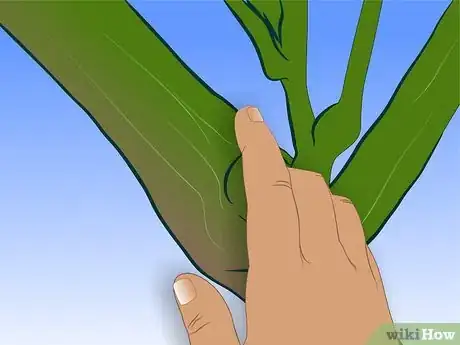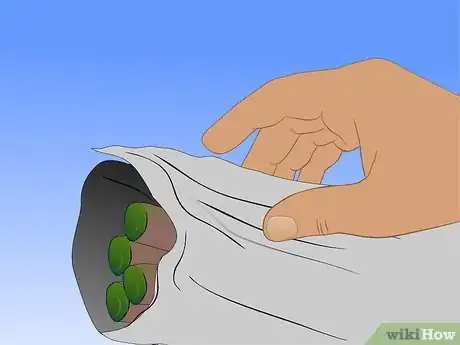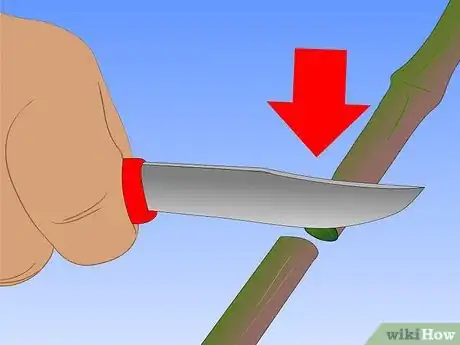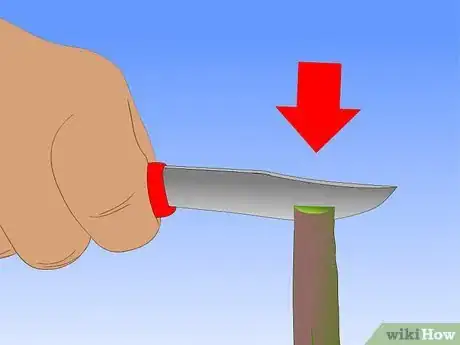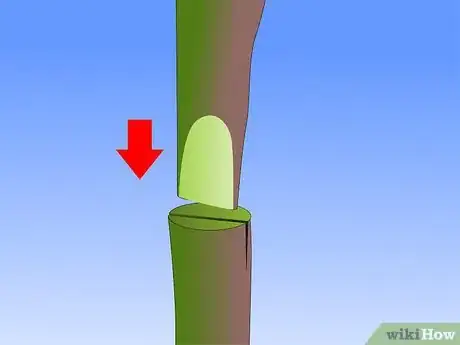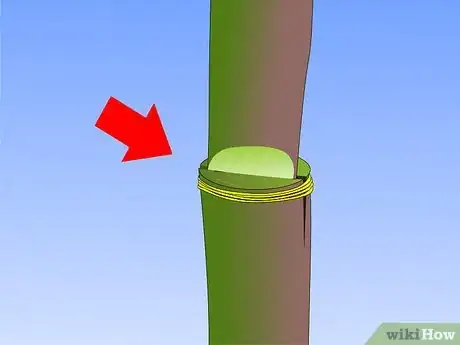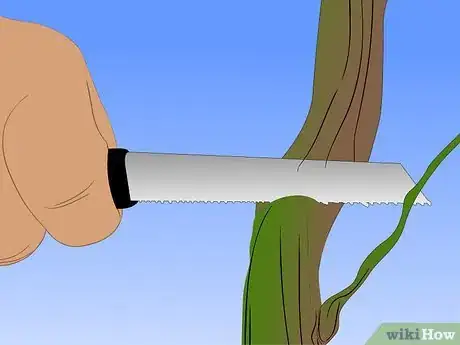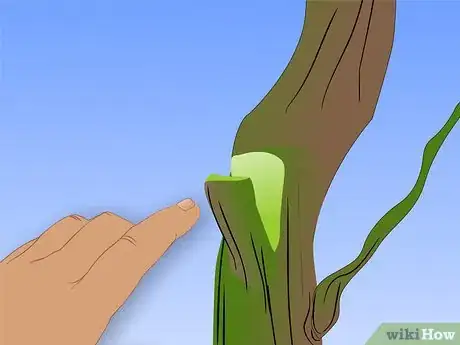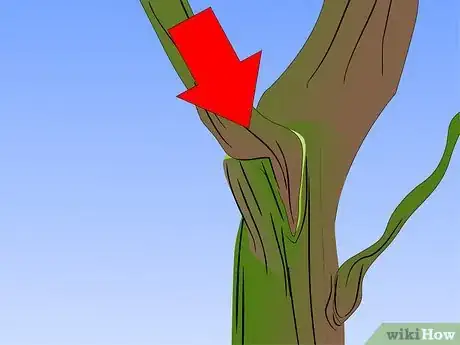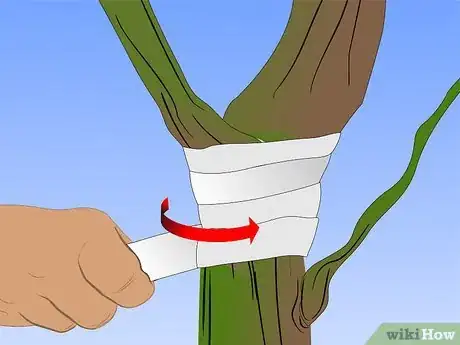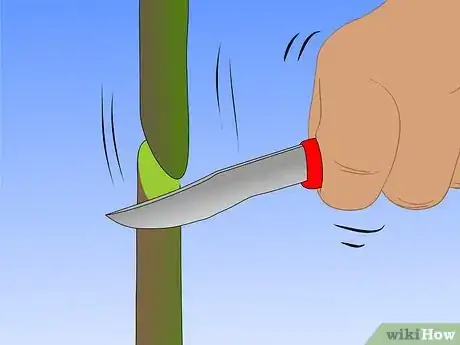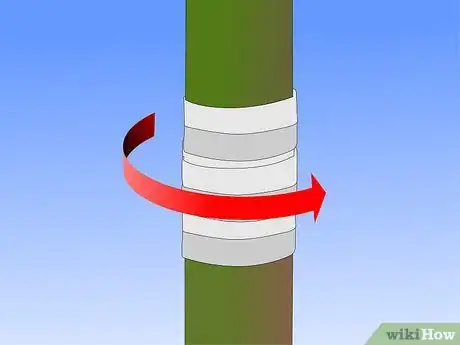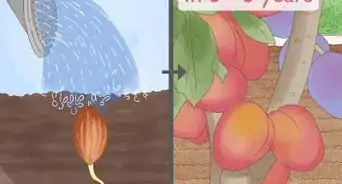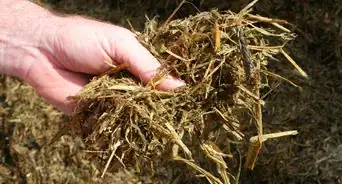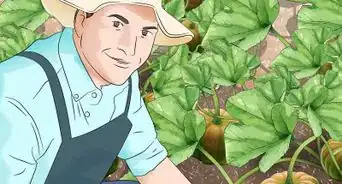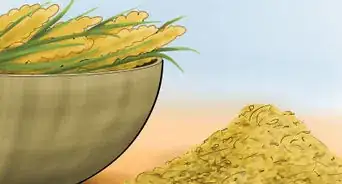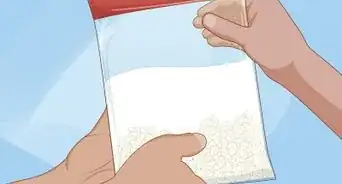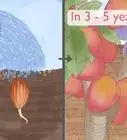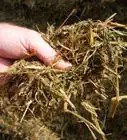X
wikiHow is a “wiki,” similar to Wikipedia, which means that many of our articles are co-written by multiple authors. To create this article, volunteer authors worked to edit and improve it over time.
This article has been viewed 58,756 times.
Learn more...
Grafting can be used as a way to inexpensively propagate new fruiting varieties in a vineyard. There are multiple ways to graft a new Grapevine onto an old one, but some of the easiest and most successful include cleft grafting, bark grafting, and whip grafting.
Steps
Before You Begin: Collecting and Storing Scion Wood
-
1Collect canes during the dormant stage.[1] The best time to collect scion wood is during the middle of winter, usually during January or February.
- Scion wood refers to smaller, younger shoot systems that you graft onto older vines. In contrast, the stock or rootstock is the mature vine growing in the ground that the scion is grafted onto.
- Wait until well after a major freeze occurs. Doing so reduces the risk of accidentally damaging the fresh shoots.
-
2Choose healthy plants.[2] You should only take scion wood from healthy, established vines that show no sign of disease, injury, or other stress.
- For best results, you should also look for canes that have received plenty of sunlight. Avoid canes that grew primarily in shade.
Advertisement -
3Cut long enough canes. [3] The canes you cut for use as scion wood can range in length from 4 inches (10 cm) to 2 feet (0.61 m) (61 cm). Each cane of scion wood should have at least two buds, if not more.
- For longer scion wood, make sure that the canes you cut have buds in multiples of two (two, four, six, eight, etc.).
- Select round canes that are 5/16 inches (7.9 mm) to 9/16 inches (14.3 mm) in diameter.
- Use a sharp blade to make a flat cut on the bottom of the cane and an angled cut on the top of the cane. Make sure that there is excess stem extending beyond the buds on either end, too.
-
4Store the scion wood canes in moist, cool conditions. Wrap the scion wood in moist newspaper and place the bundles in a plastic bag. Seal the bags and keep them in a cellar or similar area that consistently remains at temperatures just above freezing.
- It's best to bundle scion wood in groups of 100, but smaller groups can work if necessary.
- Ideal temperatures range between 34 and 36 degrees Fahrenheit (1.1 and 2.2 degrees Celsius).
- Remove the scion wood from storage a full day before you intend to graft the vines. Allow them to sit out and gradually reach the current outdoor temperature.
Advertisement
Method 1
Method 1 of 3:
Method One: Cleft Graft
-
1Cut the top of the vine.[4] Select a fairly large stock vine and saw off the top roughly 30 minutes before you intend to graft the scions.
- Note that this is the simplest grafting method to use and generally produces good results.
- You should cut the top based on the desired head height of the grafted vine. Make the cut at a clean, unblemished portion of the vine and cut until the height of the rootstock is roughly 4 inches (10 cm) shorter than your final desired head height.
-
2Split the stock. Use a cold chisel or similar splitting blade to split the rootstock down the center of its top surface.
- This split needs to be at least 2 inches (4 cm) deep.
- Hold this split open while you prepare the scions by keeping the chisel inside.
-
3Taper the scions. Select two dormant scions and taper the bottoms into a "v" shape using a sharp, clean blade.
- Make straight, even cuts that taper down from the lowest bud to the bottom of the scion. The tapered edge should be about 2 inches (4 cm), or about as long as the rootstock split is deep.
- Note that the outer edge of the scion is usually a little wider than the inner edge. Cutting the wood in this way makes it easier for the scion to come into contact with the correct part of the rootstock.
- The bottom of the taper should be about 1/16 inch (1.6 mm) wide.
-
4Place the scions in the split. Wedge the tapered bottom of one scion into one side of the rootstock split. Wedge the other scion into the other side of the split.
- Remove the chisel before fitting the scions. If necessary, use a large, flat screwdriver to hold one side of the split open as you wedge a scion inside.
- Push the scions down until the cambium layers of the scions and rootstock meet. The cambium is the single layer of active plant cells located just beneath the bark. The connection between the two separate vines will establish itself at this level.
-
5Seal the split. Wrap the sides of the split with rubber bands or tape. Apply grafting compound to the entire exposed split.
- Sealing the split seals existing moisture in and keeps excess moisture out.
- Apply the grafting compound very generously using a wide, stiff paintbrush.
- For extra protection, you may even wish to apply interior latex paint over the dried grafting compound.
Advertisement
Method 2
Method 2 of 3:
Method Two: Bark Graft
-
1Remove the top of the vine.[5] Choose a vine with slipping bark, then cut away the top of the vine with a saw.
- This method is also among the simplest grafting methods for grape vines, but it tends to be slightly less particular and slightly less successful than cleft grafting.
- Bark slipping occurs when the bark actually begins to separate and peel away from the wood of the vine. Ideally, you should wait until all of the bark on a vine begins to split before trying to use this grafting method.
- You only need to cut 4 inches (10 cm) or so from the top of the vine. You can cut more if you desire a shorter head height, though.
-
2Cut a pattern into the basal end of the scion. Select a dormant scion and slice off a portion of bark and wood along the bottom half of the shoot using a sharp, clean blade.
- This cut should be about 2 inches (4 cm) long and should be straight yet slanted. For best results, position this cut on the opposite side of the bud.[6]
- Make a secondary cut on the opposite (bud) side of the scion. This cut should be similar in shape but only one-third the length of the primary cut.
-
3Make a matching cut in the stock. Use the same blade to cut into the side of the rootstock, near the cut top. The portion you cut away should match the shape and size of the portion removed from the scion.
- Remove the loose outer bark from the intended grafting location.
- Hold the cut edge of the scion against the intended grafting location on the stock. Cut a slit into the bark on both sides. The slit should be as wide as the diameter of the scion and as deep as the full scion length.
-
4Insert the scion into the cut. Slip the cut surface of the scion into the newly cut wedge of in the rootstock.
- You may need to use a flat screwdriver to help you peel away the flap of bark on the stock. Roughly one-third to one-half of this flap should be removed before you place the scion into the wedge.
- The long side of the scion should be placed against the trunk of the stock.
-
5Seal the grafted area. Wrap the grafted vines together with a durable rubber band or heavy-duty tape. Seal the entire exposed area with grafting compound.
- For additional security, hold the graft together with 1-inch (2.5-cm) long brads or staples from a staple gun. Seal as normal, then apply latex paint over the dried grafting compound.
Advertisement
Method 3
Method 3 of 3:
Method Three: Whip Graft
-
1Slice away the bottom of the scion.[7] Use a sharp blade to cut the bottom of the scion at a slant. The exposed surface should measure between 1 and 2 inches (2.5 and 5 cm) from the lowest to highest point.
- This method is a little more difficult than cleft and bark grafting, but it is still fairly simple and works best when you're dealing with young, thing vines.
- Note that the scion diameter should roughly match the diameter of the rootstock vine you plan to use.
-
2Cut the top of the stock at a similar angle. Use a saw or sharp blade to cut the top of the rootstock at an angle and length that matches the cut of the scion.
- This process is best done on vines that are only one or two years in age. The vines must be no greater than 3/4 inch (1.9 cm) in diameter, making this method ideal for vines that are too small to be grafted using cleft or bark grafting.
-
3Match the cambium layers. Position the scion over the rootstock. Arrange them so that the cambium layers of vine meet.
- The cambium is a single layer of active plant cells found just beneath the bark of the vine. The two vines must be connected at their cambium layers if they are to join into one vine.
- If the rootstock is wider than the scion, you may need to settle for matching the cambium layer on one side of the graft only.
-
4Cut a tongue into both pieces. Slice into the rootstock with a sharp blade, then mirror this slice in the scion. The two sliced portions of wood should be able to fit together.
- Both cuts should start roughly one-quarter of the way down from the point of sloped cut on both the scion and the stock.
- These tongues help hold the graft together more securely and keep the structure a little more rigid.
-
5Seal the grafted area. Wrap the grafted area of the vine with heavy-duty tape or similar material, then apply a generous layer of grafting compound over all of the exposed vine.
- Sealing is important with all methods, but it is especially important with this one. Make sure that you are using thick grafting rubber tape or electrical tape when wrapping the grafted area.
- Apply a generous amount of asphalt grafting compound with a stiff paintbrush and add a coat of interior latex paint over the grafting compound once it dries.
Advertisement
Community Q&A
-
QuestionWhen is the best time to complete grafting?
 Community AnswerBud grafting is usually done around late summer when buds are suitably developed. Scion-type grafting as described above is done in spring, ideally while scion still dormant.
Community AnswerBud grafting is usually done around late summer when buds are suitably developed. Scion-type grafting as described above is done in spring, ideally while scion still dormant. -
QuestionIs it okay to graft my vines in spring?
 Community AnswerThe summer is the best time for grafting, but you could do it in the spring as well. However, you must make sure there's no danger from any sudden frost.
Community AnswerThe summer is the best time for grafting, but you could do it in the spring as well. However, you must make sure there's no danger from any sudden frost. -
QuestionMy root stock is 15 years old and 4 or 5 inches across. Can I still graft to it?
 Community AnswerYes, you can. Just follow the regular grafting procedure, and your vines will flourish!
Community AnswerYes, you can. Just follow the regular grafting procedure, and your vines will flourish!
Advertisement
Things You'll Need
- Handsaw or chainsaw
- Chisel or splitting blade
- Hammer
- Flat screwdriver
- Clean, sharp blade
- Grafting compound
- Rubber bands
- Heavy-duty tape
- Interior latex paint
- Wide, stiff paintbrush
References
- ↑ http://berrygrape.org/an-illustrated-guide-to-field-grafting-grapevines/
- ↑ https://www.canr.msu.edu/news/selecting_and_storing_scion_wood_for_grafting
- ↑ https://www.canr.msu.edu/news/selecting_and_storing_scion_wood_for_grafting
- ↑ https://aggie-horticulture.tamu.edu/propagation/cleftgrafting/cleftgrafting.html
- ↑ https://extension.wsu.edu/chelan-douglas/agriculture/treefruit/horticulture/bark_grafting/
- ↑ http://cetulare.ucanr.edu/files/82000.pdf
- ↑ https://aggie-horticulture.tamu.edu/propagation/whipgrafting/
About This Article
Advertisement

